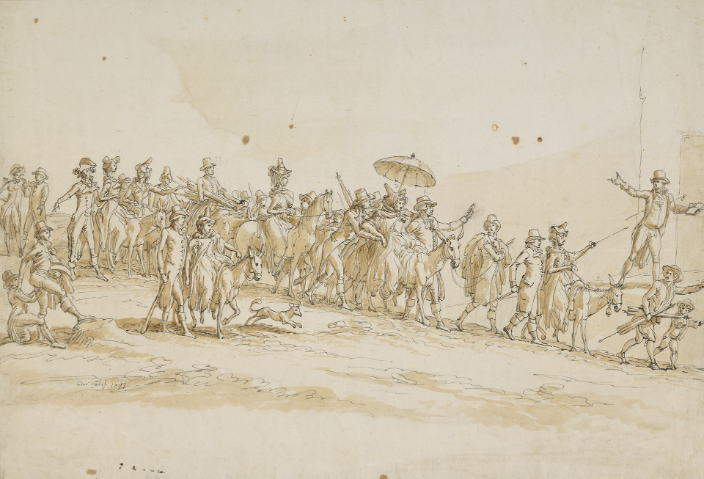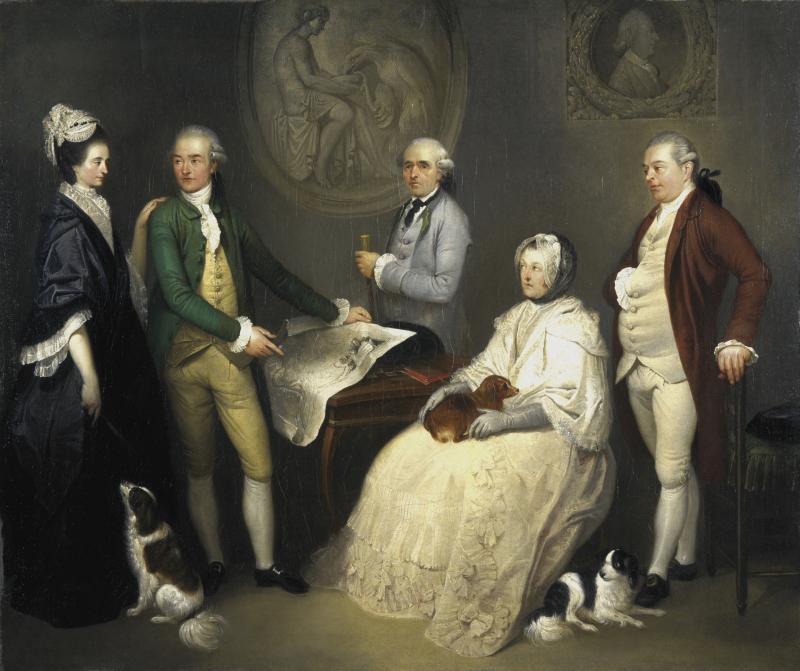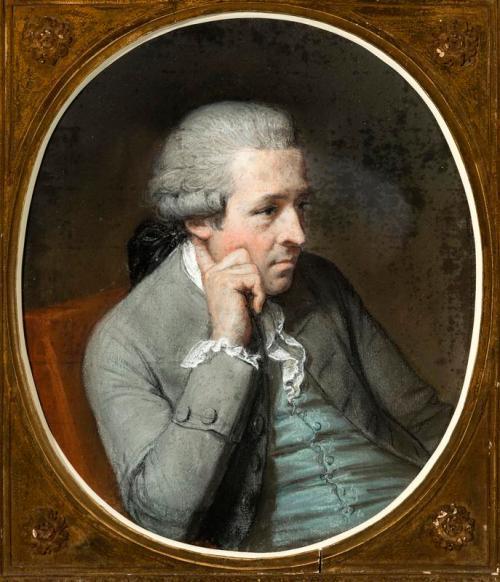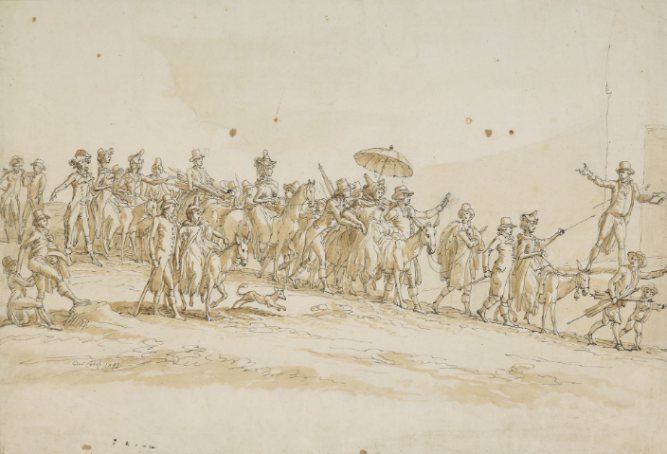Abstract
James Byres settled in Rome in the 1750s and lived in the Eternal City for over thirty years, at a time when the Grand Tour reached its height of popularity. Working as a guide, antiquarian, art dealer and architect, Byres rapidly became a key player in Rome’s artistic, cultural and social life. Thanks to his various professional activities, he was a central figure in the social practices of the British Grand Tourists and artists who visited Rome.
Keywords
The Scotsman James Byres lived for over thirty years in Rome, where he became one of the main players in the artistic, cultural and social life of the second half of the eighteenth century. Within a few years, he was one of the most sought-after guides and art dealers. His fame made him a central figure in the social practices of the travellers of the Grand Tour and of the artists who came to finish their training in the Eternal City.
James Byres was born in 1734 in Tonley to a Jacobite1 family in Aberdeenshire, in the northeast of Scotland. Forced into exile following the 1745-46 uprising in favour of the Stuart cause, Byres and his family lived first in France before moving to Rome, where a large Jacobite community had been established since 1719.2 When he settled in the city in 1756 or 1758, he aspired to a career as a painter and studied in the studio of the famous history painter Anton Raphael Mengs. However, on Mengs's advice, Byres abandoned painting to specialise in architecture.3
- 1. Jacobite was the name given to the supporters of the exiled Stuart family, who had been removed from the British throne in 1688.
- 2. In 1719, the Stuarts and their court had settled in Rome following an invitation from Pope Clement XI.
- 3. Mengs seemed to have advised Byres to specialise in miniature painting but, instead, he studied architecture.
In 1762, he won the third prize of the Concorso Clementino, a competition organised by the Accademia di San Luca, and became a member of this institution in 1768. Despite this prestigious award and appointment, Byres was unable to secure enough commissions to make a living as an architect, and he soon embarked on a much more lucrative career without abandoning his artistic ambitions. Indeed, by the 1760s, Byres had not one but four professional activities, as he was a guide, an antique dealer, an art dealer and an architect.4 He formed a partnership with his brother-in-law Christopher Norton5 and his nephew Patrick Moir, who continued to manage Byres's business when the latter returned to Scotland permanently in 1790. Each of these activities depended on the other and enabled him to become a central link in the artistic networks in Rome and Britain. As a guide, he showed the city to travellers on the Grand Tour, to whom he also often offered his services as an art dealer and architect. Byres' success was largely due to his ability to maintain good relations with the Grand Tourists, who were his main clients, and with the artists and Italian nobility who supplied him with the works of art he sold. He was an artistic and commercial agent who created a bond between the artists working in Rome and the British art collectors who visited the city.
- 4. Byres completed few architectural projects. For an overview of his career as an architect see Harry Gordon Slade’s article referenced in the further reading section.
- 5. James Byres and Christopher Norton are both represented in the group portrait entitled ‘James Byres of Tonley and Members of His Family’ by Franciszek Smuglevicz. Byres, who is standing next to his sister, his pointing to a map and Christopher Norton is on the far right of the canvas. Patrick Moir sat for his portrait to Henry Raeburn, when the painter visited Rome in the mid-1780s.
The second half of the eighteenth century marked the height of the Grand Tour and, of all the Italian cities they visited, it was usually in Rome that travellers spent the most time. This educational journey, which sometimes lasted several years, was undertaken by young aristocratic and gentry men. The purpose of the Grand Tour was to complete the education of young travellers by helping them to develop social skills and polished manners thanks to their contact with European elite. In order to best prepare them to evolve into fashionable society, they also needed to have a solid artistic culture, to which the guides, also called ciceroni, contributed. In Rome, besides Byres, several other British residents worked as guides for Grand Tourists, such as the Scotsman Colin Morison and the Englishman Thomas Jenkins, who was Byres’s main rival. Byres took advantage of his status as a guide and an artist to enrich his local and international networks. He became a reference on the Roman and British art markets. For instance, in 1780, the Welsh painter Thomas Jones wrote that Byres was ‘the principal Antiquarian to the English, or person who attended Strangers to shew & explain the Various Buildings both Modern & antient, Statues & pictures & other Curiosities in this City & its Environs’.6 Among his clients, with the exception of a few travellers from North America, Byres counted mostly British gentlemen. Philip Yorke (later 3rd Earl of Hardwick), Charles Townley, Lord Richard Cavendish, Charles Long (later Lord Farnborough), Sir Watkin Williams-Wynn and Douglas Hamilton (later 8th Duke of Hamilton) were some of his most prestigious clients. In their correspondence or in their journals, many of them described Byres’s personality and erudition as a guide. For example, in 1764, Edward Gibbon wrote of him: ‘my guide was Mr. Byers, a Scotch antiquary of experience and taste’.7 Dr. John Moore, tutor to Douglas Hamilton, who visited Rome with Byres in 1775-76, described him as being ‘a gentleman of probity, knowledge and real taste’.8
- 6. Thomas Jones, ‘Memoirs of Thomas Jones: Penkerrig Radnorshire 1803’, The Volume of the Walpole Society (vol. 32, 1946-1948), p. 1-143, here p. 94.
- 7. Edward Gibbon, The Miscellaneous Works of Edward Gibbon, Esq. with Memoirs of His Life and Writings, Composed by Himself, vol. 1 (London: John Murray, 1814), p. 196.
- 8. John Moore, A View of Society and Manners in Italy: with Anecdotes Relating to some Eminent Characters, 5th ed., 2 vols. (London: A. Strahan and T. Cadell, 1790), vol. 1, p. 383.
Visiting the major historical and artistic sites of Rome with Byres usually took five to six weeks. As Dr. John Moore explained, when in Rome, Douglas Hamilton's days were usually organised in two parts:
Our mornings are generally spent in visiting the antiquities, and the paintings in the palaces. On those occasions we are accompanied by Mr. Byres […]. We generally pass two or three hours every evening at the conversazionis; I speak in the plural number, for we are sometimes at several in the same evening. It frequently happens, that three or four, or more, of the nobility, have these assemblies at the same time; and almost all the company of a certain rank in Rome make it a point, if they go to any, to go to all. (Moore, vol. 1, 383)
These guided tours of the city, which were in effect a course on historical and artistic sites of interest, not only enriched the travellers' culture, but also provided an opportunity to meet and interact with other Grand Tourists. As Giuseppe Cades recalls in his drawing entitled Gavin Hamilton Leading a Party of Grand Tourists to the Archaelogical Site at Gabii, the tours organised by guides such as Hamilton and Byres included several participants, usually between five and seven people. In addition to increasing the travellers' knowledge, their artistic tastes and preferences were permanently influenced by their contact with Byres.
The exchanges between the latter and his clients were not limited to the visits of the city. The painter William Patoun pointed out in his Advice on Travel that Byres had ‘the honour of dining often with All the Young Men of Rank that travail’.9 Byres regularly had guests for breakfast and he hosted dinner parties at his home for travellers who were potential customers for his art dealing and architecture business. This was an opportunity for him to show them his art gallery where he exhibited the works of art he sold. Thus, the young John Ramsay, who visited Italy between 1782 and 1784 with his father the famous portrait painter Allan Ramsay, recorded that he was invited for breakfast at Byres’s,
[w]here was Mr Slaney, Mr Norton, Mr Beauclerk, Sr Giuseppe. After brakfast Mr Byres carried us into his Room of Antiquity’s in which he show’d us some valuable things. Particularly a very fine picture of Corregio (Venus rising out of the Sea) & a very fine landskape by Claud Lorrain.10
In turn, Byres was also frequently invited by the British who were staying in the city.
While living in Rome, the Ramsays, father and son, had the opportunity to meet James Byres on many occasions. John Ramsay wrote that on 25 December 1782, he dined at Byres's with a large number of guests ‘went and dined with Mr Byres where was Monsignore Stoner, Mr Morris, the Abbè Grant, Mr Morrison [the Scottish artist, guide and antiquarian Colin Morison], Mr Heweston [the Irish sculptor], Abbè Butler, and others whose names I have forgot’ (Ingamells 2003, 94). Byres's Christmas dinner was particularly well known to the British and illustrated the rivalry between Byres and Jenkins, who also held a Christmas dinner for Grand Tourists and artists. Indeed, Thomas Jones stated in his diary:
Being Christmass day a number of us, to the Amount of 14 or 15, dined according to an Annual Custom, with our Patron the great Mr Jenkins - There had been a kind of Schism in the body of Students of late Years, on Account of Mr Byers giving a dinner on the same day - He, of course, attached his Countrymen, the Scotch, and one or two more to his party - I had, indeed, myself been first introduced to Mr B – […] but […] dining with Mr J - and receiving a formal invitation to his christmass feast, imperceptibly enlisted under his Banner. (Jones 53)
When in Rome, if they hoped to benefit from the commissions of the Grand Tourists, British artists, like Jones, had to associate themselves with either Byres or Jenkins. As guides, Byres and Jenkins identified potential clients among the travellers who visited the city with them. They acted as intermediaries or agents between the artists and the young British aristocrats who took advantage of their stay in Rome to enrich their personal collection.
Thus, thanks to Byres's personal network, several British travellers were able to pose for the famous portraitist Pompeo Batoni. They were also able to acquire major works in the history of Western European art, such as the series of paintings of the Seven Sacraments by Nicolas Poussin, now on display at the National Galleries of Scotland. William Hamilton, the British ambassador to Naples, acquired through Byres the famous Portland Vase, now in the British Museum.
Because of his various professional activities and his success as a guide and art dealer, Byres was a key figure in the artistic and social life of Rome. The ties he forged with his clients and artists lasted well beyond their stay in the Italian peninsula as, on their return to Britain, some art collectors continued to purchase works of art through Byres.
Share
Further Reading
Brinsley Ford, Richard, ‘James Byres: Principal Antiquarian for the English Visitors to Rome’, Apollo (vol. 99, 1974), p. 446-461.
Coen, Paolo, ‘Andrea Casali and James Byres: The Mutual Perception of the Roman and British Art Markets in the Eighteenth Century’, Journal for Eighteenth Century Studies (vol. 34, n° 3, 2011), p. 291-313.
Coen, Paolo, Il Mercato dei quadri a Rome nel diciottesimo secolo, 2 vols. (Florence: Olschki editore, 2010).
Gibbon, Edward, The Miscellaneous Works of Edward Gibbon, Esq. with Memoirs of His Life and Writings, Composed by Himself, vol. 1 (London: John Murray, 1814).
Peters Bowron, Edgar, and Rishel, Joseph J., Art in Rome in the Eighteenth Century (Philadelphia: Philadelphia Museum of Art, 2000).
Skinner, Basil, Scots in Italy in the 18th Century (Edinburgh: Trustees of the National Galleries of Scotland, 1966).
Slade, Harry Gordon, ‘James Byres of Tonley: The Architecture of a Scottish Cicerone’, The Journal of the Architectural Heritage Society of Scotland (vol. 26, 1991), p. 18-28.
Yarker, Jonathan, and Hornsby, Clare, ‘Buying Art in Rome in the 1770s’, in M. D. Sánchez-Jáuregi and S. Wilcox (eds.), The English Prize: The Capture of the Westmorland, An Episode of the Grand Tour (New Haven: Yale Center for British Art, 2012), p. 62-87.



